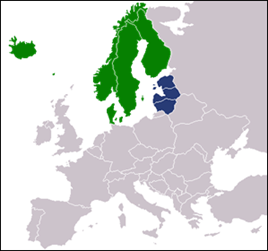
THE VOICE OF INTERNATIONAL LITHUANIA
|
VilNews has its own Google archive! Type a word in the above search box to find any article.
You can also follow us on Facebook. We have two different pages. Click to open and join.
|

By Aage Myhre
I believe many of our readers have heard about or even studied the so-called Triple Helix model that emphasizes the need of cooperation and interaction between science, industry and government. I believe this is an extremely interesting model also for a Nordic-Baltic cooperation, as it describes an intensification of a process and a shortening of the time span between discovery and utilization, and increased reliance of industry on knowledge originated in academic institutions.
As knowledge becomes an increasingly more important part of innovation, the university (science and education) as a knowledge-producing and disseminating institution plays a larger role in business innovation. In earlier times, innovation was an activity formerly and largely performed by the industry or government, or depending upon the social system, a bilateral interaction between these two institutional spheres. In a knowledge-based economy, however, the university becomes a key element of the innovation system both as human capital provider and seedbed for new firms. The three institutional spheres (public, private, and academic) – that formerly operated at arms’ length – are increasingly interwoven with a spiral pattern of linkages emerging at various stages of the innovation and industrial policy-making process. Furthermore, in addition to these institutional linkages among spheres, each sphere may take up the role of the other.
A triple helix of university-business-government relations transcends previous models of institutional relationships, whether socialist (No. 1) or laissez-faire (No. 2), in which either the polity or economy predominated and with the knowledge playing a subsidiary role.

Triple Helix 1: The communist model.
An etatist or socialist model of university-industry-government relations
(where the Baltic States were during the Soviet period).

Triple Helix 2: The laissez-faire model.
A laissez-faire model of university-industry-government relations
(where the Baltic States very much are today).

Triple Helix 3: The Scandinavian model.
This triple helix model is an attempt to account for a new configuration of institutional forces emerging within innovation systems (a stage the Nordic countries to a quite high degree have reached), and I believe this is a good model for joint cooperation and innovation between the Nordic and the Baltic States.

Triple Helix 4: The endless transition model.
Triple Helix no. 4 is one in which the overlay of communications and expectations at the network level guides the reconstructions of institutional arrangements. It is not expected to be stable and the sub-dynamics in the innovation process are continuously reconstructed through discussions and negotiations. What is considered as ‘industry’, what as ‘market’ cannot be taken for granted. Each ‘system’ is defined and can be redefined as the research project is designed. Thus, the triple helix hypothesis is that systems can be expected to remain in an endless transition.
This model indicates that innovation and cooperation should take place across sectors and country boundaries, for example that a university in Sweden very well could work with a business venture in Lithuania, and I believe the combination of Triple Helix 3 and 4 is a good solution for cooperation and collaboration within the Baltic-Nordic region as this will lead to increased integration and development that will give us advantages ahead of most other regions of the world.
My experience from Lithuania does, however, not make me too optimistic about the situation for cross-sector cooperation. I was, for example, asking the General Director of Omnitel (the leading mobile phone operator in Lithuania) about the situation for higher education within technology. His answer was that one single word would be description enough; „It‘s bad!“
And a few years ago I asked the General Director of the Libra Group (a leading Lithuanian company within wood processing) to tell me what kind of support and help he had from the authorities in his important business. His short answer was: „I don‘t expect anything from them, and I‘m happy as long as they don‘t create problems for me“.
- Bookmark :
- Digg
- del.icio.us
- Stumbleupon
- Redit it
VilNews e-magazine is published in Vilnius, Lithuania. Editor-in-Chief: Mr. Aage Myhre. Inquires to the editors: editor@VilNews.com.
Code of Ethics: See Section 2 – about VilNews. VilNews is not responsible for content on external links/web pages.
HOW TO ADVERTISE IN VILNEWS.
All content is copyrighted © 2011. UAB ‘VilNews’.

 Click on the buttons to open and read each of VilNews' 18 sub-sections
Click on the buttons to open and read each of VilNews' 18 sub-sections 



Excellent, Aage!
Unfortunately, we still have those legacies when all the lines of institutional collaboration were parallel: from LT to Moscow. Anything more complex and/or multi-directional than that was viewed with strong suspicion by the KGB and with quite a good dose of justification. During the Soviet occupation, the sovnarkhozy attempt at such reform by LT was also suspect. As a legacy of the occupation, now everybody is suspicious of everybody as such trans-institutional cooperation is just out of the Soviet LT genes:). The Sajudis failure to conduct the Czech style lustration to weed big bolshevik traitors out of future power in free LT just conserved those bad legacies.
Valdas Samonis
Toronto